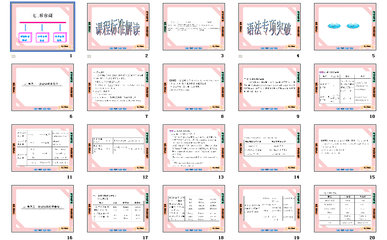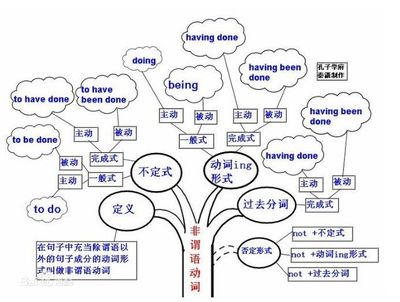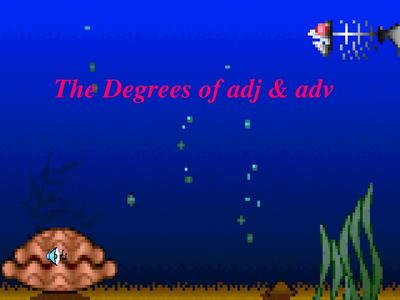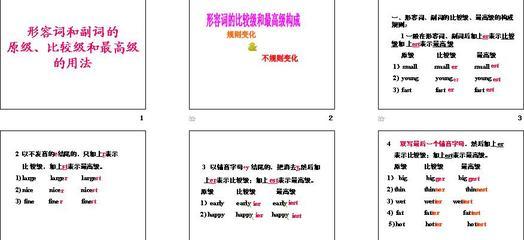形容词是用于描写或修饰名词或代词的词,它可以表示人或事物的性质、特征、状态和属性,在句中可用作定语、表语、补语、状语等。如:
It's a beautiful car. 那是一辆漂亮的汽车。(作定语)
The children are clever. 这些孩子很聪明。(作表语)
All of them fell asleep. 他们都睡着了。 (作表语)
We find the question very difficult.我们发现这个问题很难。(作宾补)
He sat in the corner,silent. 他坐在角落里,一言不发。 (作状语)
副词
副词主要用于修饰动词,也可用于修饰形容词、副词、动词、介词短语以及句子,表示时间、地点、方式、程度、疑问等。如
He often comes late. 他经常迟到。(修饰动词)
We rather like English. 我们非常喜欢英语。(修饰动词)
It's almost impossible. 那几乎是不可能的。(修饰形容词)
He drove very fast. 他开车开的很快。(修饰副词)
She looks very much like her mother.她看上去很她母亲。(修饰介词短语)
形容词变副词:
1.多数情况下, 副词是形容词+'-ly'形式:
形容词 副词
cheap
quick
slow
cheaply
quickly
slowly
例如:
Time goes quickly.
He walked slowly to the door.
She certainly had an interesting life.
He carefully picked up the sleeping child.
如果形容词以'-y'结尾, 用'i'代替'y'再加 '-ly':
形容词 副词
easy
angry
happy
lucky
easily
angrily
happily
luckily
如果形容词以-'able', '-ible', or '-le', 结尾,则用'-y'代替“e":
形容词 副词
probable
terrible
gentle
probably
terribly
gently
如果形容词以'-ic'结尾,加 '-ally':
形容词 副词
basic
economic
tragic
basically
economically
tragically
注意: 例外: public - publicly
2. 有的形容词与副词形式相同:
形容词/ 副词
early
fast
hard
high
late
near
straight
wrong
比较:
It is a fast car.
He drives very fast.
This is a hard exercise.
He works hard.
We saw many high buildings.
The bird flew high in the sky.
1. 形容词------1.1 形容词及其基本用法
形容词修饰名词,说明事物或人的性质或特征。通常,可将形容词分成性质形容词和叙述形容词两类,其位置不一定都放在名词前面。 1) 1) 直接说明事物的性质或特征的形容词是性质形容词,它有级的变化,可以用程度副词修饰,在句中可作定语、表语和补语。例如:hot。
2) 2) 叙述形容词只能作表语,所以又称为表语形容词。这类形容词没有级的变化,也不可用程度副词修饰。大多数以a开头的形容词都属于这一类。例如:afraid 害怕的。
(错) He is an ill man.
(对) The man is ill.这个人生病了。
(错) She is an afraid girl.
(对) The girl is afraid. 这个女孩很害怕。
这类词还有: well,unwell,ill,faint,afraid,alike,alive,alone,asleep,awake 等。
33) 形容词作定语修饰名词时,要放在名词的前边。但是如果形容词修饰以-thing为字尾的词语时,要放在这些词之后。例如:something nice.
1.2 多个形容词修饰名词的顺序
多个形容词修饰名词时,其顺序为:限定词--数词--描绘词--(大小,长短,形状,新旧,颜色)--出处--材料性质--类别--名词。例如: a small round table/ a tall gray building/ a dirty old brown shirt/ a famous German medical school/ an expensive Japanese sports car
限定词 delicious, lovely, charming
大小/长短 small,huge,tiny,long,short
新旧/温度 old, hot, young
形状 round, square, rectangular
颜色 red, blonde, black
出处(国籍) Swedish, Victorian, Chinese
材质 plastic, wooden, silver
典型例题:
1) Tony is going camping with ___ boys.
A. little two other B. two little other C. two other little D. little other two
答案:C。由"限定词--数词--描绘词--(大小,长短,形状,新旧,颜色) --性质--名词"的顺序可知数词,描绘词,性质依次顺序,只有C符合答案。
2) One day they crossed the ____bridge behind the palace.
A. old Chinese stone B. Chinese old stone C. old stone Chinese D. Chinese stone old
答案A. 几个形容词修饰一个名词,他们的排列顺序是:年龄,形状,大小+颜色+来源+质地+用途+国家+名词。
3) ---- How was your recent visit to Qingdao?
---- It was great. We visited some friends,and spent the ___days at the seaside.
A. few last sunny B. last few sunny C. last sunny few D. few sunny last
答案:B。本题考查多个形容词的排序问题。一般与被修饰形容词关系密切的形容词靠近名词;如果几个形容词的重要性差不多,音节
少的形容词在前,音节多的方在后,在不能确定时,可参照:限定词+数量词(序数词在前,基数词在后)+性状形容词+大小、长短、高
低等形体+新旧+颜色+国籍+材料+名词,如those + three + beautiful + large + square +old + brown + wood + table。
1.3 以-ly结尾的形容词
1) 大部分形容词加-ly可构成副词。但 friendly,deadly,lovely,lonely,likely,lively,ugly,brotherly,仍为形容词。
改错: (错) She sang lovely.
(错) He spoke to me very friendly.
(对) Her singing was lovely.
(对) He spoke to me in a very friendly way.
2) 有些以-ly 结尾既为形容词,也为副词,如daily,weekly,monthly,yearly,early等。例如:
The Times is a weekly paper. 《时代周刊》为周刊。
The Times is published weekly. 《时代周刊》每周发行一期。
1.4 用形容词表示类别和整体
1)某些形容词加上定冠词可以泛指一类人,与谓语动词的复数连接,如the dead,the living,the rich,the poor,the blind,the hungry等。例如:
The poor are losing hope. 穷人将失去希望。
2) 2)有关国家和民族的形容词加上定冠词指这个民族的整体,与动词的复数连用,如the British,the English,the French,the Chinese等。例如:
The English have wonderful sense of humor. 英国人颇有幽默感。
2. 副词------2.1 副词及其基本用法
副词主要用来修饰动词,形容词,副词或其他结构。
一、副词的位置
1)表示确定的时间副词,地点副词和一些方式副词一般放在句末。如果句末同时出现几个副词,其顺序是:方式副词 地点副词 时间副词
He went to London yesterday.
I saw your keys somewhere.
He closed the door quietly.
2)频度副词一般放在行为动词,助动词,系动词,情态动词后
She always goes to school at seven.
You have often been told not to do it.
3)程度副词一般放在被修饰的形容词,副词或动词前(enough除外)
This is a very good book.
She studies much harder now.
I quite understand.
The hall is big enough to hold 5,000 people.
4)一些方式副词修饰不及物动词时,放在被修饰的动词之后
He works hard.
5)修饰及物动词时,放在被修饰的动词之前或宾语之后
He speaks English very well.
6)副词修饰名词时放在名词之后:
The young people there are from Beijing.
7)修饰全句的副词常放在句首
Truly he will go to Shanghai.
8)疑问副词放在句首
Where is the book?
9)关系副词和连接副词放在定语从句和名词性从句之首
This is the house where I once lived.
I don't know where he lives.
10)及物动词和副词(如up,over,on,off,down,in out等)组成的动词词组又名词作宾语时,该名词可放在副词之后或之前,如果宾语为代词,该代词一定要放在副词之前
Don't give (the plan) up (the plan).
Don't give it up.
注意:
a. 大多数方式副词位于句尾,但宾语过长,副词可以提前,以使句子平衡。例如:
We could see very clearly a strange light ahead of us.我们清楚地看到前面有奇怪的光。
b. 方式副词well,badly,hard等只放在句尾。例如:
He speaks English well. 他英语说得好。
二、副词的排列顺序:
1) 时间,地点副词,小单位的在前,大单位在后。
2) 方式副词,短的在前,长的在后,并用and或but等连词连接。例如:
Please write slowly and carefully. 请写得慢一些,仔细一些。
3) 多个不同副词排列:程度+地点+方式+时间副词。
注意:副词 very 可以修饰形容词,但不能修饰动词。
改错:(错) I very like English.
(对) I like English very much.
注意:副词enough要放在形容词的后面,形容词enough放在名词前后都可。
例如:
I don't know him well enough. 他我不熟悉。
There is enough food for everyone to eat.有足够的食物供每个人吃。
There is food enough for everyone to eat.
2.2 副词的分类
(一)按照意义分类:
1.时间副词:
now,soon,ago,today,early,finally,once,recently,already等
何时: today, yesterday, later, now, last year
多久: all day, not long, for a while, since last year
2.地点副词:
here,downstairs,above,back,upwards,nearby,outside,off
3.方式副词:
carefully,fast,angrily,warmly,suddenly,slowly,really,excitedly,hard,well等
4.程度副词:
almost,nearly,very,rather,fairly,so,much,deeply,quite等
5.频度副词:
once,always,seldom,often,usually,sometimes,occsionally等
(二)按照功能分类:
1.一般副词:包括上述时间,地点,方式,程度,频度等副词,主要在句中作状语,定语,表语,宾语补足语和介词宾语
2.疑问副词:如how,when,why,where放在特殊疑问句首
3.关系副词:如when,where,why,引导定语从句
4.连接副词:如 how,when,where,why,whether,引导名词性从句
(三)三种特殊的副词
1.与形容词同形的副词:
high,deep,hard,daily,early,fast,near,low,far,little,straight,pretty,enough,only,direct等
2.以-ly结尾的形容词
friendly,lovely,lonely,homely,manly,motherly,brotherly,worldly等
3.有一些副词既与形容词同形又可以以-ly结尾
He is a hard worker.他是个勤奋的工人(形容词)
He works hard.他努力工作(副词)
He hardly words.他几乎不工作(副词)
2.3 兼有两种形式的副词
1) close与closely
close意思是"近";closely 意思是"仔细地"。例如:
He is sitting close to me. 他就坐在我边上。
Watch him closely. 盯着他。
2) late 与lately
late意思是"晚";lately 意思是"最近"。例如:
You have come too late. 你来得太晚了。
What have you been doing lately? 近来好吗?
3) deep与deeply
deep意思是"深",表示空间深度;deeply时常表示感情上的深度,"深深地"。例如:
He pushed the stick deep into the mud.他把棍子深深插进泥里。
Even father was deeply moved by the film.老爸也被电影深深打动了。
4) high与highly
high表示空间高度;highly表示程度,相当于much。例如:
The plane was flying high. 这架飞机飞得很高。
I think highly of your opinion. 你的看法很有道理。
5) wide与widely
wide表示空间宽度;widely意思是"广泛地","在许多地方"。例如:
He opened the door wide. 他把门开得大大的。
English is widely used in the world.英语在世界范围内广泛使用。
6) free与freely
free的意思是"免费";freely 的意思是"无限制地"。例如:
You can eat free in my restaurant whenever you like.无论什么时候,我这饭铺免费对你开放。
You may speak freely; say what you like.你可以畅所欲言,想说什么就说什么。
3. 形容词和副词的比较级和最高级
大多数形容词(性质形容词)和副词有比较级和最高级的变化,即原级、比较级和最高级,用来表示事物的等级差别。原级即形容词的原形,比较级和最高级有规则变化和不规则变化两种。
一. 形容词的比较级和最高级变化:
1) 规则变化
音节数量 比较级 最高级
单音节 + -er + -est
tall taller tallest
以一个辅音字母结尾的闭音节单音节词,双写结尾的辅音字母,再加-er,-est:
fat fatter fattest
big bigger biggest
sad sadder saddest
音节数量 比较级 最高级
双音节 + -er OR more + adj + -est OR most + adj
以-y, -ly, 结尾的词,"以辅音字母+y"结尾的双音节词,改y为i,再加-er,-est
以-le,或者 -ure结尾的词,加-r;以-er,-ow结尾的双音节词未尾加-er,-est
happy happier/ more happy happiest/ most happy
yellow yellower/ more yellow yellowest/ most yellow
simple simpler/ more simple simplest/ most simple
tender tenderer/ more tender tenderest/ most tender
如果你不确认,用 MORE + OR MOST +
注意:"以辅音字母+y"结尾的双音节词,改y为i,再加-er,-est
busy busier busiest
音节数量 比较级 最高级
三个以上的音节 more + adj most + adj
important more important most important
expensive more expensive most expensive
例如:
a. A cat is fast, a tiger is faster but a cheetah is the fastest
b. A car is heavy, a truck is heavier, but a train is the heaviest
c. A park bench is comfortable, a restaurant chair is more comfortable, but a sofa is the most comfortable
2) 不规则变化
原级 比较级 最高级
good better best
well(健康的) worse worst
bad
ill(有病的)
old older/elder oldest/eldest
much/many more most
little less least
far farther/further farthest/furthest
二. 副词的比较级和最高级变化:通常说来,副词的比较级和最高级与形容词的比较级最高级形式相同:
短副词后加-er or -est:
副词 比较级 最高级
hard harder the hardest
late later the latest
fast faster the fastest
例如:
Jim works harder than his brother.
Everyone in the race ran fast, but John ran the fastest of all.
以-ly结尾的副词,用 more+副词做比较级, most+副词做最高级 :
副词 比较级 最高级
quietly more quietly most quietly
slowly more slowly most slowly
seriously more seriously most seriously
例如:
The teacher spoke more slowly to help us to understand. Could you sing more quietly please?
有的副词有不规则的比较级形式
副词 比较级 最高级
badly worse worst
far farther/further farthest/furthest
little less least
well better best
例如: The little boy ran further than his friends.
You're driving worse today than yesterday !
注意!有时候 'most'意味着 'very':
We were most grateful for your help
I am most impressed by this application.
4. 形容词、副词比较等级的基本用法------4.1 as + 形容词或副词原级 + as
1)在否定句或疑问句中可用so… as。例如:
He cannot run so/as fast as you. 他没你跑得快。
Mont Blanc is not as high as Mount Everest . Norway is not as sunny as Thailand . A bicycle is not as expensive as a car. Arthur is not as intelligent as Albert .
2)当as… as 中间有名词时采用以下格式:as +形容词+ a +单数名词/ as + many/much +名词。例如:
This is as good an example as the other is. 这个例子和另外一个一样好。
I can carry as much paper as you can. 你能搬多少纸,我也能。
3)用表示倍数的词或其他程度副词做修饰语时,放在as的前面。例如:
This room is twice as big as that one. 这房间的面积是那间的两倍。
Your room is the same size as mine. 你的房间和我的一样大。
4)倍数+ as + adj. + as <=> 倍数+ the … + of。例如:
This bridge is three times as long as that one. 这座桥的长度是那座的三倍。
This bridge is three times the length of that one.
Your room is twice as large as mine. 你的房间是我的两倍大。
Your room is twice the size of mine.
4.2 比较级形容词或副词 + than
1)要避免重复使用比较级。
(错) He is more cleverer than his brother.
(对) He is more clever than his brother.
(对) He is clever than his brother.
2)要避免将主语含在比较对象中。
(错) China is larger than any country in Asia.
(对) China is larger than any other countries in Asia.
3)要注意对应句型,遵循前后一致的原则。
The population of Shanghai is larger than that of Beijing.
It is easier to make a plan than to carry it out.
4)要注意定冠词在比较级中的使用。
比较:Which is larger, Canada or Australia?
Which is the larger country, Canada or Australia?
She is taller than her two sisters.
She is the taller of the two sisters.
4.3 the + 最高级 + 比较范围
1)形容词最高级前通常必须用定冠词 the,副词最高级前可不用。例如:
The Sahara is the biggest desert in the world. 撒哈拉沙漠是世界上最大的沙漠。
形容词most前面没有the,不表示最高级的含义,只表示"非常"。例如:
It is a most important problem. =It is a very important problem. 这是个很重要的问题。
注意:使用最高级要注意将主语包括在比较范围内。
(错) Tom is the tallest of his three brothers.
(对) Tom is the tallest of the three brothers.
2)下列词可修饰最高级,by far, far, much, mostly, almost。例如:
This hat is nearly / almost the biggest. 这帽子差不多是最大的了。
注意:
a. very可修饰最高级,但位置与much不同。
This is the very best.
This is much the best.
b. 序数词通常只修饰最高级。例如:
Africa is the second largest continent.非洲是第二大洲。
3) 最高级的意义有时可以用比较级表示出来。例如:
Mike is the most intelligent in his class. 马克是班上最聪明的。
Mike is more intelligent than any other students in his class.
4) "否定词语+比较级","否定词语+ so… as"结构也可以表示最高级含义。例如:
Nothing is so easy as this. 没比这更简单的了。
=Nothing is easier than this.
=This is the easiest thing.
5. 形容词、副词比较等级的其他用法------5.1 可修饰比较级的词
1)a bit, a little, rather, much, far, by far, many, a lot, lots, a great deal, any, still, even等。
2)还可以用表示倍数的词或度量名词作修饰语。
3)以上词(除by far)外,必须置于比较级形容词或副词的前面。
典型例题:
1)---- Are you feeling ____?
---- Yes,I'm fine now.
A. any well B. any better C. quite good D. quite better
答案:B. any 可修饰比较级,quite修饰原级,well的比较级为better.
2)The experiment was____ easier than we had expected.
A. more B. much more C. much D. more much
答案:C. much可修饰比较级,因此B,C都说得通,但easier本身已是比较级,不需more,因此C为正确答案。
3)If there were no examinations, we should have ___ at school.
A. the happiest time B. a more happier time C. much happiest time D. a much happier time
答案:D。
5.2 和more有关的词组
1) the more…the more… 越……就越……。例如:
The harder you work,the greater progress you'll make. 越努力,进步越大。
2) more B than A=less A than B 与其说A不如说B。例如:
He is more lazy than slow at his work. = He is less slow than lazy at his work. 他工作时,与其说是反应慢不如说是懒。
3) no more… than… 与……一样……,不比……多。例如:
The officials could see no more than the Emperor. 官员们看到的和皇帝一样多。
no less… than… 与……一样……。例如:
He is no less diligent than you. 他和你一样勤勉。
4) more than 不只是,非常。例如:
She is more than kind to us all. 她对我们非常热心。
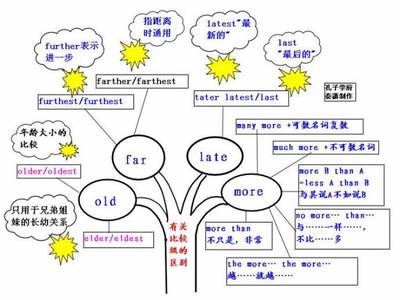
典型例题
1)The weather in China is different from____.
A. in America B. one in America C. America D. that in America
答案:D. 本题意为"中国的天气比美国热。"比较的是天气而不是国家,C不能选。A没有名词,后句成分不全,排除。B和D中,B中的one常用来代替可数名词,而that可车以代替不可数或抽象名词,所以选D。
2)After the new technique was introduced,the factory produced ___ tractors in 1988 as the year before.
A. as twice many B. as many twice C. twice as many D. twice many as
答案C. 此句意为"这个厂1988能生产的拖拉机是往年的两倍"。表示倍数用"倍数+ as + 形容词原形+ as +比较对象"的句型。所以此句答案为C。
6. 需特别注意的 many、much,old 和 far
1) 如果后接名词时,much more +不可数名词,many more +可数名词复数。
2) old 有两种比较级和最高级形式: older/oldest 和elder/eldest。elder,eldest 只用于兄弟姐妹的长幼关系。例如:
My elder brother is an engineer. 我哥哥是个工程师。
Mary is the eldest of the three sisters. 玛丽是三姐妹中最大的。
3) far 有两种比较级,farther,further。一般father 表示距离,further表示进一步。例如:
I have nothing further to say. 我没什么要说了。
7. 常见近义副词的比较------7.1 always,usually,sometimes,rarely,never
频率副词: always,usually,sometimes,rarely,never
always usually sometimes rarely never
100%的时间 0%的时间
在带动词 be 的句子里应把频率副词放在动词的后面。
They are always happy.
The food is never good here.
在带其他动词的句子中时,频率副词放在动词的前面:
We usually go to the beach on Saturday.
She sometimes cooks spaghetti.
I rarely travel.
7.2 表示程度的副词 almost, nearly, quite, just, too, enough, hardly, scarcely, completely, very, extremely.
表示程度的副词:Almost, nearly, quite, just, too, enough,very, hardly, scarcely, completely, extremely.
表示程度的副词通常放在:
修饰的形容词或副词之前:
如. The water was extremely cold.
主要动词之前:
如. He was just leaving. She has almost finished.
例子:
She doesn't quite know what she'll do after university.
They are completely exhausted from the trip.
I am too tired to go out tonight.
He hardly noticed what she was saying.
Enough, very, too 的比较
1)Enough作副词时表示”到了一定程度“放在形容词及副词之后
例如:
Is your coffee hot enough? (形容词) He didn't work hard enough. (副词)
也可放在名词前,表示 '足够了'. 这里不作副词,而是 '限定词'.
例子:
We have enough bread. They don't have enough food.
2)Too作副词放在形容词及副词之前.
This coffee is too hot. (形容词) He works too hard. (副词)
Enough和 too加上形容词可以跟 'for someone/something'.
例如:
The dress was big enough for me. She's not experienced enough for this job. The coffee was too hot for me. The dress was too small for her.
我们也可以'to + 不定式'用于 enough和 too+形容词(副词)之后
Example:
The coffee was too hot to drink. He didn't work hard enough to pass the exam. She's not old enough to get married. You're too young to have grandchildren!
3)Very 用于形容词及副词之前使语气更强烈.
例如:
The girl was very beautiful. (形容词) He worked very quickly. (副词)
注意! too和 very的用法上有巨大的差异.
Very表示事实:
He speaks very quickly. Too则暗示有问题:
He speaks too quickly (for me to understand).
其他类似 very 的副词:
extremely, especially, particularly, pretty, rather, quite, fairly, rather, not especially, not particularly.
注意: rather 可以是肯定或否定,取决与它修饰的形容词及副词:
肯定: The teacher was rather nice
否定: The film was rather disappointing.
注意在倒装句中的否定副词:
通常主语放于动词之前:
主语 动词
I
She
left
goes
然而,有的否定副词引起倒装句--动词需置于主语之前
例如:
I have never seen such courage. Never have I seen such courage.
She rarely left the house. Rarely did she leave the house.
还有类似的词及短语需要使用倒装句:
seldom, scarcely, hardly, not only .....but also, no sooner .....than, not until, under no circumstances
 爱华网
爱华网